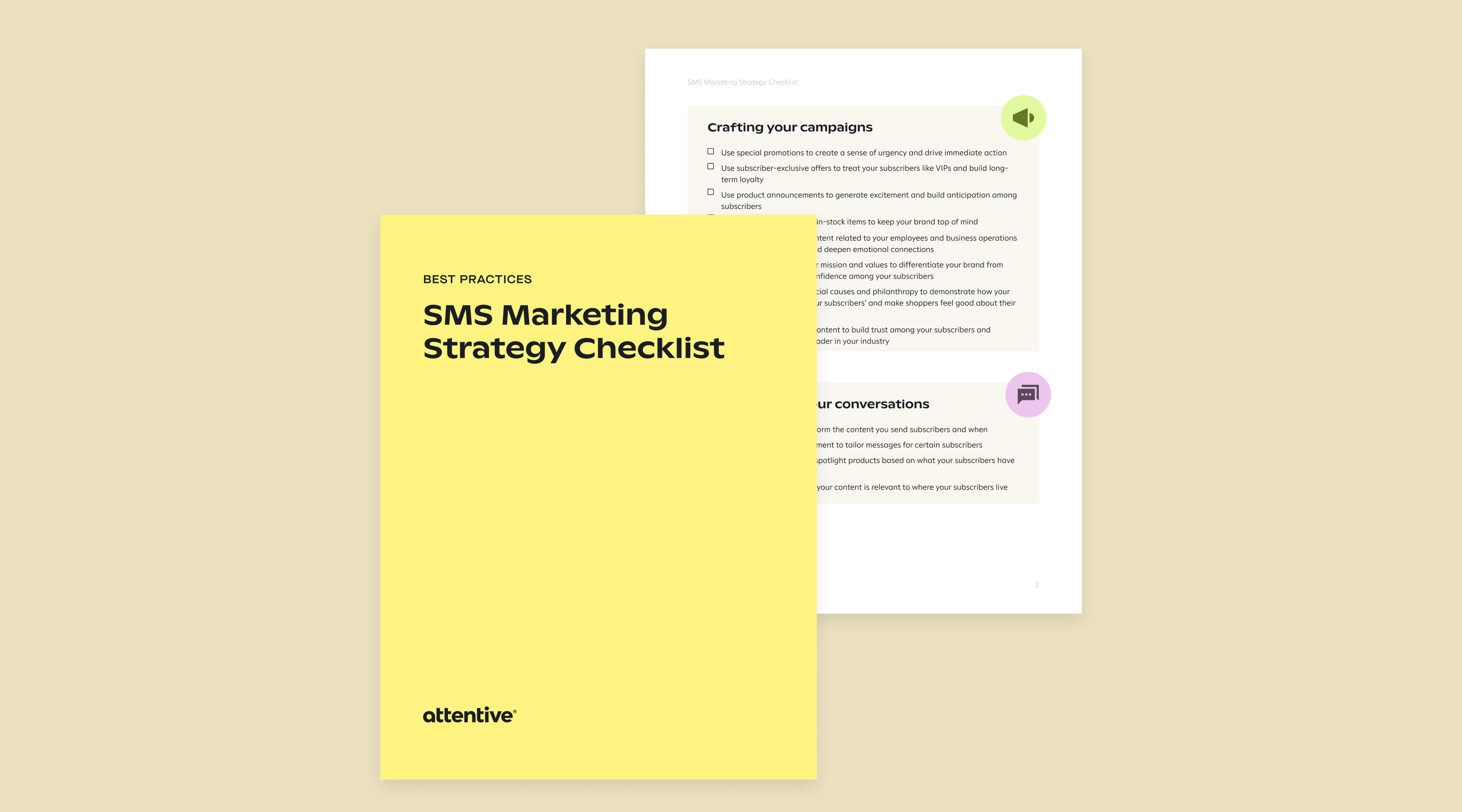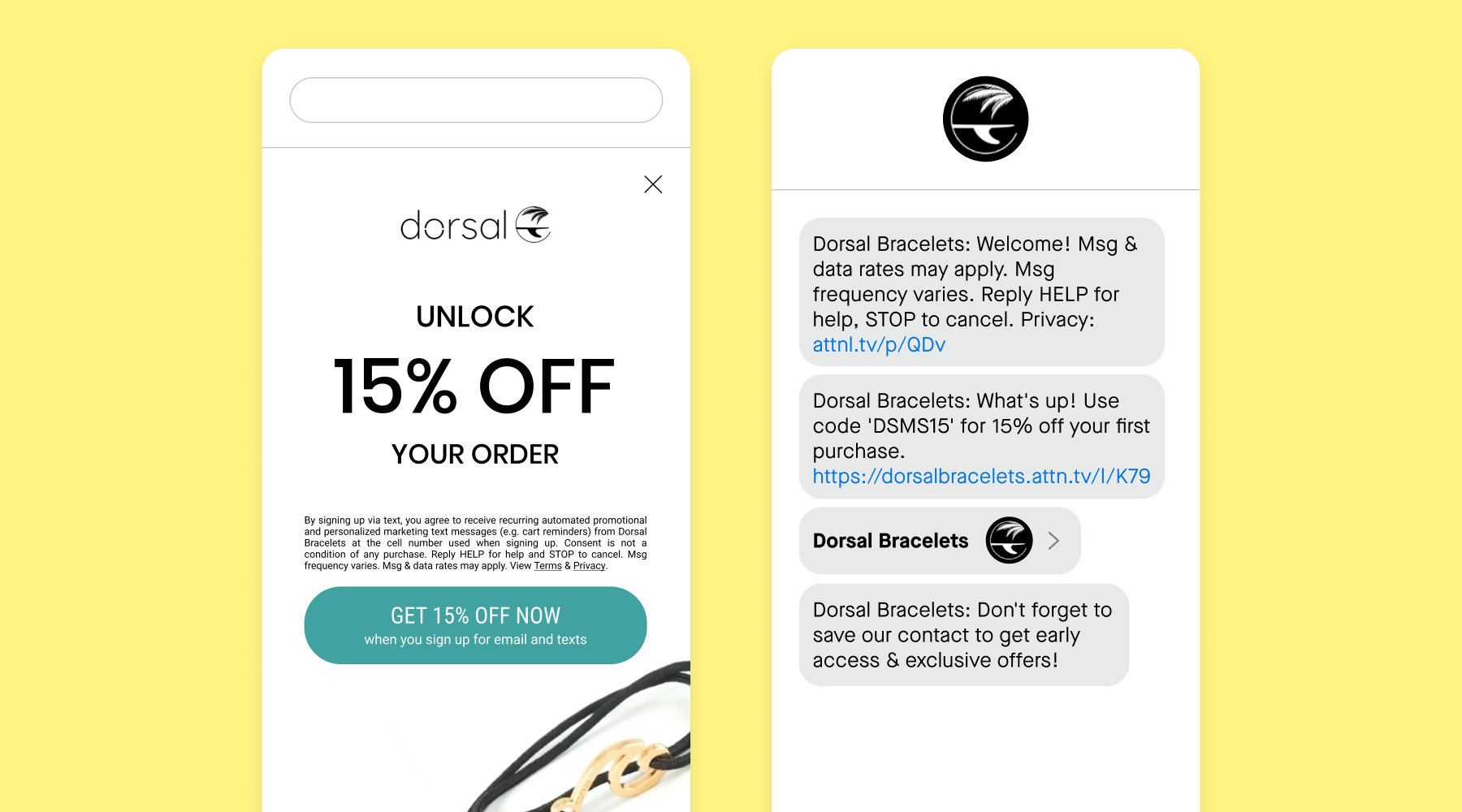
New releases
A smarter, simpler Attentive
Explore new features →
Explore new features →

US consumers spend a lot of time on their mobile devices (about 4.5 hours a day). So it’s no surprise that the SMS inbox is a great place for brands to reach them.
Not only do text messages have an average 97% read rate within 15 minutes of delivery, but the average click-through rate for SMS is 20-35%.
Consumers are also happy to let their favorite brands text them. Many even end up shopping when they get a message that piques their interest. 81.2% of consumers are signed up for at least one brand’s SMS program, and 63% of them have made a purchase from a text message within the last three months.
If you’re ready to invest in SMS, the first step is to choose the best SMS provider for your business. Then, you can start creating a text message marketing strategy that aligns with and helps you achieve your goals.

Consider this your complete guide to getting started with best practices and tips for sending text messages that drive engagement, revenue, and retention. Plus, download our easy-to-reference checklist to make sure all of your SMS bases are covered. From list growth recommendations to foundational segments, use this template as a guide to get the most out of your SMS program.
When you're launching any new marketing channel, it’s important to get a strategic foundation in place first. SMS is no different. Here's what you need to do to lay the groundwork for your strategy, so you can launch and scale it successfully.
Disclaimer: the materials in this section are for informational purposes only, and not for the purpose of providing legal advice. You should contact your legal counsel to obtain advice with respect to any particular issues or problems.

SMS is a regulated channel with its own set of rules and requirements. Before you start texting your customers, familiarize yourself—and your team—with the best practices for SMS compliance.
Here’s a quick primer on the regulations you need to know and adhere to in the United States:
Keep in mind: the right SMS vendor should be well-versed in compliance laws and be able to provide you with guidance and recommendations on how to navigate them.
Want to learn more about the basics of TCPA, CTIA, and ADA requirements? Check out our marketer’s guide to SMS compliance.
One question we get asked a lot, especially from marketers who are new to text message marketing, is “Who should run my SMS program?” The answer is that it depends—on your brand, the size of your team, your goals for the channel, and more.
For some brands, SMS fits within an existing team or function, like digital, CRM, or email marketing. Others have a dedicated SMS marketer (or a small team) that owns the channel and strategy. But you also have the option of working with a digital marketing agency that specializes in SMS.
Whatever you decide, you want the person or team owning your SMS program to have a strong grasp on mobile marketing and your brand voice.
In your early days with SMS, figure out what your goals are for the channel, how you’ll meet them, and how you’ll define and measure success. It’s also a good idea to think about how you can use text messaging to boost your broader brand and business goals.
Some metrics to consider, whether you're focused on customer acquisition, increasing retention and repeat purchases, or driving revenue:
Just like with your other marketing channels, the goals you set help shape your overall strategy, from how you attract new subscribers to the types of messages you send your audience.
Growing a healthy subscriber base is key to the success of any text messaging program. The larger the list, the more people you can reach and influence through SMS.
There are four main things to think about when creating your list growth strategy:
You don’t have to tackle all of these things at once. Instead, determine where you want to focus your efforts first and build your strategy from there.
For example, when you’re starting out, your website should be a top priority. You’re already driving traffic there on desktop and mobile, so that’s where you have the biggest opportunity to convert your customers into SMS subscribers.
Make sure your sign-up unit offers shoppers something of value in exchange for opting in. We’ve found that discounts are typically the most effective incentive, but they're not your only option. You can also hint at exclusive first access to product launches and the opportunity to “stay in the know,” or encourage customers to join your loyalty or rewards program.

As you scale, expand your list growth efforts to other channels where you have an engaged audience: email, social media, and even offline, if you have a brick-and-mortar store. We also recommend experimenting with different opt-in incentives to see what types of offers work best.
Want more tips for growing your SMS list? Check out our definitive guide with best practices and examples.
While you focus on building up your subscriber base, it makes sense to send text messages to your entire SMS list, so you can maximize your reach. But as your audience gets bigger, tailoring your messaging to appeal to different groups can help increase engagement and ROI.
The first step to sending the right texts to the right people is understanding your subscribers’ individual interests and tastes. One way to do this is by creating dynamic segments based on your subscribers' activity in real time, like the products they've browsed or purchased.

Another option is to use our Preference Collection forms, which allow someone to share their product category and content preferences as part of the opt-in experience. But you can also ask your subscribers directly about what they like through two-way text messaging.
Gathering these insights is how you create an effective segmentation strategy that keeps your subscribers engaged with relevant, personalized content.
There are four types of text messages you can send to engage your subscribers, and they each serve a different purpose. Depending on your brand’s goals for SMS, you’ll want to focus on incorporating a healthy mix of one-time campaigns, triggered messages, two-way conversations, and transactional messages into your strategy.
Let’s break down the difference between each kind of message:
Campaigns are one-time or single-send messages that you can schedule in advance based on your marketing content calendar, or send on-demand to drive more sales in real time.

They’re ideal for creating a sense of urgency, like when you have limited-time deals and promotions and want subscribers to click-through and shop immediately. But you can also use campaign text messages to:
For many brands, the agility of SMS also allows them to come up with campaign ideas on the fly, and execute them same-day to capitalize on relatable or cultural moments.
Also known as journeys, triggered text messages are sent based on specific behaviors or actions your subscribers take, like browsing your website or joining your SMS program. They allow you to engage individual subscribers and encourage them to convert at key moments in their customer journey. You can use them to:

Once you set them up, triggered journeys are “always on,” helping you drive ongoing engagement and incremental revenue without any manual work for you or your team. But remember: it’s important to check in on them, re-evaluate how they’re set up, and experiment with new strategies to continually improve their performance over time.
The beauty of using SMS as a marketing tool is that it’s made for two-way communication. Conversational or two-way text messaging allows you to tap into this—by inviting your subscribers to reply to your messages directly and go back and forth with your brand.

Here are some examples of how you can use conversational messages to deliver the kind of personalization and curation that consumers are looking for:
Not only are consumers open to interacting with brands like this via text, but they also say it improves their overall shopping experience.
Transactional text messages are an important part of the customer experience. They're sent during the fulfillment process, after someone places an order or starts a new subscription, making it easy for them to track the status in real time.
There are six types of transactional messages you can send to keep your customers informed from the moment they complete their purchase to the day it arrives on their doorstep:

Sending these types of messages is also convenient for your brand because sharing status updates with your customers via text—and getting ahead of questions like, "When will my order arrive?"—can help reduce support inquiries.
The important thing to know is that transactional messages need to meet a specific set of legal and carrier requirements:
Keep these SMS marketing practices in mind as you build and evolve your channel strategy.
Discover more strategies for launching and evolving your SMS program, explore Texts We Love to get inspiration, or join our SMS 101 introductory course.